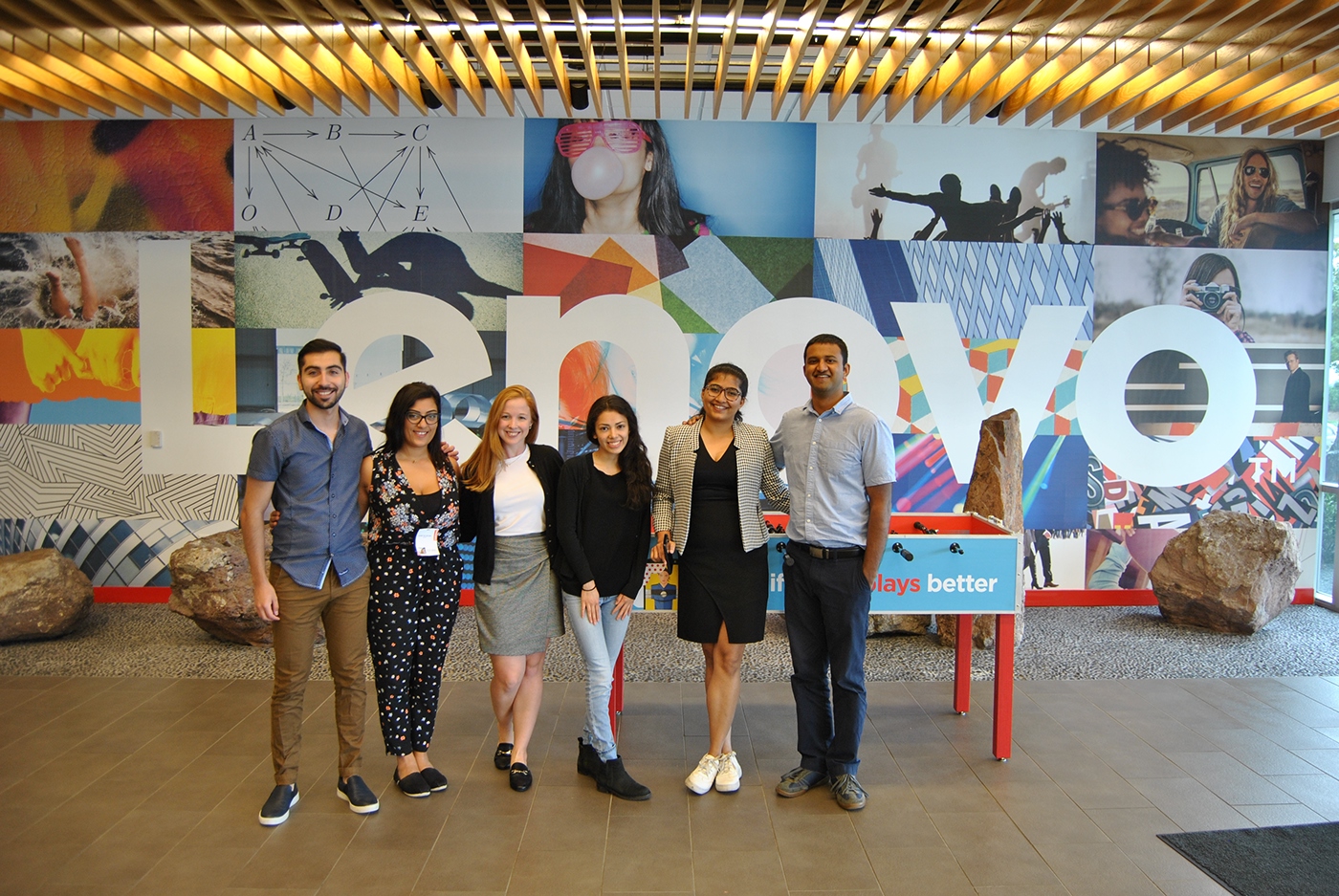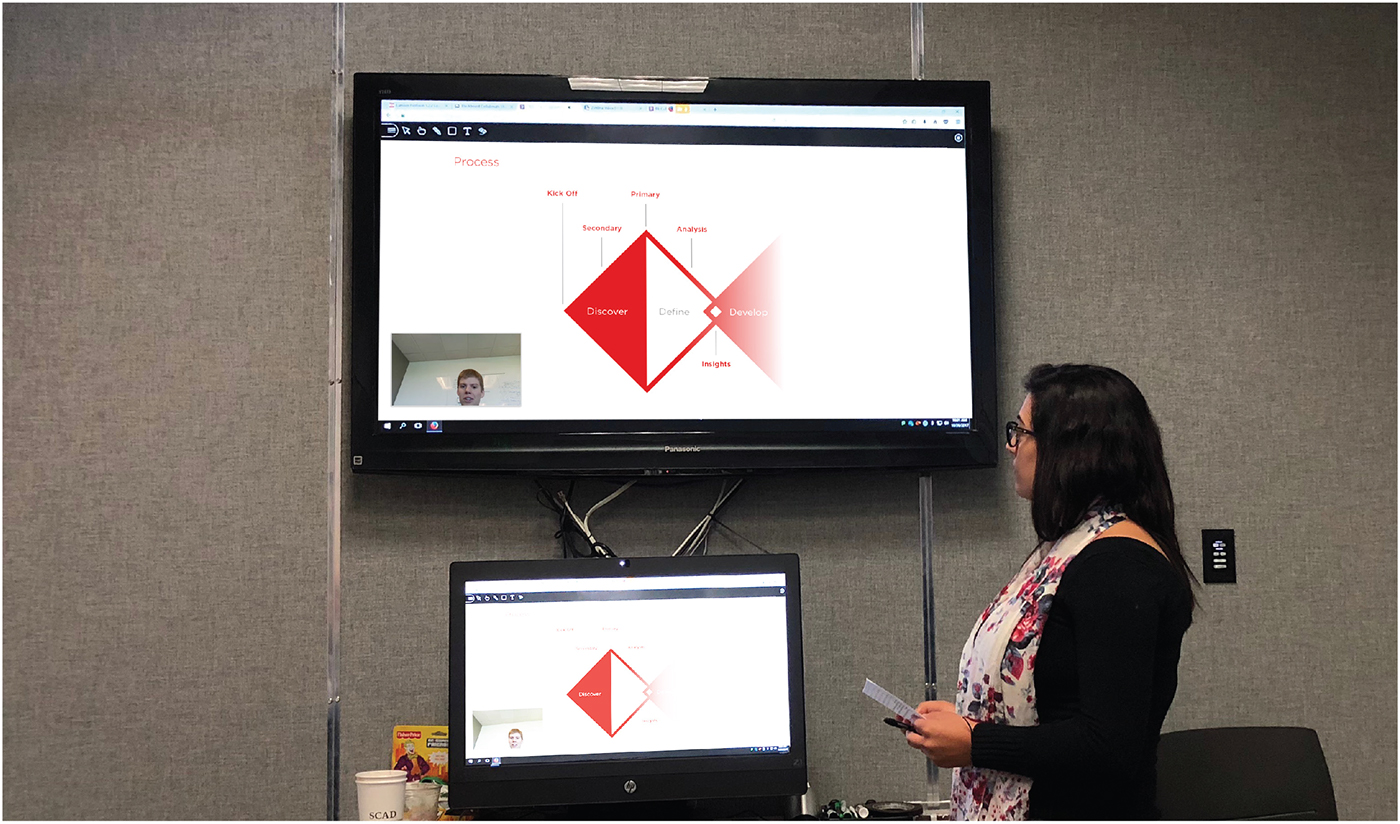Improving Collaboration at a Distance For Lenovo.
A Goal Alignment Canvas, an Empathy Workshop, and a Digital Collaborative Space for More Efficient Collaboration.

The team at Lenovo Morrisville, NC.
Client
Lenovo, a multinational company with 55,000 employees serves customers in over 160 countries. Lenovo’s portfolio includes laptops, workstations, servers, storage solutions, IT management software, smart TVs, tablets, smartphones, gaming computers, and apps.
THE Challenge
The project challenge is to conduct an independent study of Lenovo’s global design team’s communication and collaboration process with colleagues at a distance across cultures and disciplines, including external partners, and provide an in-depth report covering the strengths, weaknesses, opportunities, and threats of the company’s collaboration strategy, and to ultimately offer recommendations based on insights to support and innovate their practices.
THE Team
We are a diverse group of individuals that hail from three different continents and come from six different backgrounds. We are all in the pursuit of an M.F.A degree in Design Management from Savannah College of Art and Design. Our team is under the guidance of professor and coach, Tom Hardy. Team members include Fernando Loza, Cosette Saliba, Irene kearny, Cristina Morejon, Charithra Sathyanarayanan, and Varun Prabhu.
I helped the group in secondary research, creating an interview guide, transcribing interviews, analyzing data, brainstorming, and developing solutions. I also took part in presenting findings to Lenovo.
Project duration
The project was conducted during fall 2017 for 10 weeks. The team visited Lenovo in Morrisville, North Carolina for a field visit and interviews with the teams. Then the team had a virtual midterm and final presentation with representatives from Lenovo.



Our first meeting with Lenovo.
THE PROCESS
At the launch of our project, a kick-off meeting was held with Matt Tucker and Kwong Wing Li to address Lenovo organization and current collaboration methods. Over the course of a nine-week period, the SCAD team conducted secondary research and primary interviews with members of Lenovo’s Experience Design, UX Design, UX Testing, and CMF teams to better understand Lenovo’s needs within the context of other multinational organization’s best practices and emerging technological solutions for virtual teams. Additionally, the team relied on the following texts to guide their understanding of corporate culture and best practices for virtual teams: Creating Corporate Culture (Hampden-Turner), The Harvard Business Review’s On Collaboration, On Teams, Swarm Creativity (Gloor), and A Manager’s Guide to Virtual Teams (Zofi). Throughout this project, the SCAD team used a variety of tools to synthesize, sense-make, and brainstorm, including the affinity diagramming method to determine patterns and meaningfully cluster secondary research, observations, and interview data points. Through this methodology, key findings became verified insights, which provided the foundation for design opportunities. The SCAD team formed a valuable partnership with Lenovo Industrial Designer, Matt Tucker, with whom they regularly communicated and reported pain points, insights, and opportunities at the midway point of the project.




FINDINGS
Our research insights demonstrated that building empathy and personal relationships are fundamental for good collaboration, as indicated by these direct quotes from our interviews at Lenovo:
“Building empathy is crucial to better teamwork”.
“Being customer-centric is important, however, we need to be personnel-centric to improve retention by looking after our employees’ private lives and professional careers”.
Also, there are many issues with respect to the lack of effective standardized global communications tools. These are direct quotes from our interviews:
“We need a video conference tool that supports multiple interactions sharing and immediate responses”.
“We need new tech for communication and collaboration but have concerns about cost and international accessibility”.
Another major pain point is the existing misalignment and differences between departments. This is derived from the following insights:
Quality collaboration requires strong management/leadership and commitment to common goals and a common language.
All teams/departments should meet earlier in the process to share their knowledge and align.
We believe that there is an opportunity to improve inter and intradepartmental collaboration and communication so as to eliminate departmental differences in order to increase empathy and collaboration amongst different teams.





OUTCOME
Answering the need for internal empathy building, the SCAD team developed a recommendation for an Empathy Map Workshop with the purpose of driving empathetic understanding within team members and departments alike.
In response to the need for departmental alignment, the SCAD team developed a recommendation for a Goal Alignment Canvas tool to be used during project kick-off meetings. This canvas addresses goals, needs, and concerns to be discussed at the start of a project, resulting in time savings and shared values.
In response to the need for collaboration spaces, the SCAD team developed a recommendation for a global collaboration platform. products for utilization across all of the Lenovo design centers. These collaboration tools are all cloud-based and need servers to be locally housed on-site to ensure safety. The higher quality of visual tools in collaborative spaces will greatly alleviate issues regarding communication by boosting departmental alignment. From the range of tools identified we shortlisted the three most appropriate candidates. Additionally, we proposed developing a Wiki tool called ‘Lenovopedia’, an internal interdepartmental communications platform designed specifically for the employees of Lenovo. From the platform, employees can monitor project progress, provide presentation templates, brand guidelines, brand attributes, employee data and blog pages amongst a host of other intuitively crafted alignment solutions.



IMPACT
Findings and recommendations were presented to the representatives of Lenovo Morrisville, NC. We are still waiting for the final feedback from the VP of design.

Final presentation to Lenovo.
The process book and more details about this project can be sent upon request.

